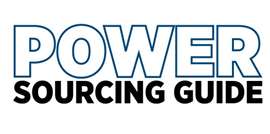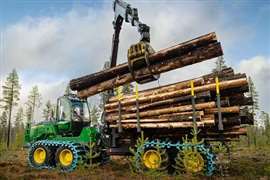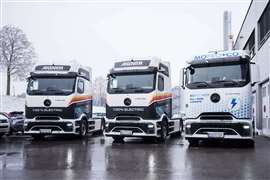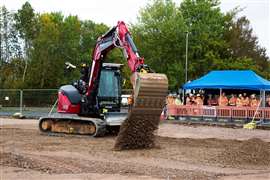Read this article in 中文 Français Deutsch Italiano Português Español
Honda and Astrobotic to explore scalable lunar power
10 October 2025
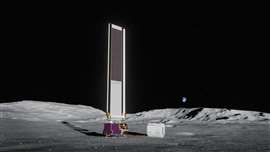 Honda RFC system integrated with the Astrobotic’s VSAT and LunaGrid. (Image: Honda/Astrobotic)
Honda RFC system integrated with the Astrobotic’s VSAT and LunaGrid. (Image: Honda/Astrobotic)
American Honda Motor Co., Inc. and Astrobotic Technology, Inc., a company dedicated to advancing space exploration and technology development, have entered into a joint development agreement aimed at developing a scalable and integrated power solution for sustained lunar surface missions.
The companies will conduct a joint feasibility study to explore how Honda’s regenerative fuel cell (RFC) system can be integrated with Astrobotic’s Vertical Solar Array Technology (VSAT) and LunaGrid scalable power infrastructure service to provide continuous power, even during prolonged periods of darkness on the Moon. The objective is to enable expanded mission capabilities, support a sustained human presence on the Moon, advance lunar surface infrastructure development and power future commercial industries.
Astrobotic is creating the LunaGrid service to supply sustained lunar surface power for a range of lunar missions and customers. A key component is the VSAT, a solar-powered system that is deployable, self-leveling and capable of sun tracking for optimal energy capture. The company is developing a 10-kW VSAT system along with the Extra-Large Vertical Solar Array Technology (VSAT-XL), which would generate 50 kW of power to support the growing power requirements of planned lunar missions.
Honda’s RFC system, known as a circulative renewable energy system, is designed to continuously produce oxygen, hydrogen and electricity using solar energy and water. In a lunar surface mission application, the system would be used to store solar power as hydrogen during the lunar day and convert it into electricity during the lunar night. The only byproduct of the RFC is water, which is recycled into the company’s high-pressure water electrolysis system to create a closed-loop energy cycle.
The companies’ joint feasibility study will focus on three key objectives:
- Conducting detailed illumination studies to assess power generation and storage requirements at different sites where the LunaGrid system will be deployed
- Evaluating the scalability of the RFC system for LunaGrid’s use
- Assessing hardware and software integration with the RFC and VSAT to define RFC system requirements that ensure reliable operation in future deployments
During the study, Honda and Astrobotic will also simulate one-year solar illumination profiles at various lunar South Pole sites using both the 10-kW and 50-kW VSAT systems. These simulated illumination profiles will determine how much sunlight the VSAT solar panels will receive on the lunar surface to power the water electrolysis during the day, enabling the RFC system to convert the stored hydrogen into electricity throughout the night.
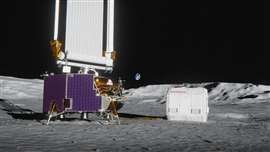 Honda’s RFC system would store solar power as hydrogen during the lunar day and convert it into electricity during the lunar night. (Image: Honda/Astrobotic)
Honda’s RFC system would store solar power as hydrogen during the lunar day and convert it into electricity during the lunar night. (Image: Honda/Astrobotic)
Based on the modeled solar energy production, Honda will size its regenerative fuel cell system to meet the energy storage needs of various lunar mission scenarios.
Derek Adelman, chief engineer, Space Development Division, American Honda Motor Co., Inc., described the collaboration as “a pivotal step toward creating scalable power solutions for long-term lunar surface missions.”
“Powered by core Honda technologies, our regenerative fuel cell system is designed to provide efficient energy storage and regeneration to support sustained human life on the Moon as well as advance zero-emission applications on Earth,” he added.
“Astrobotic’s LunaGrid is being developed to deliver reliable, continuous power for lunar surface missions, revolutionizing the economics of exploration,” stated Bobby Rolley, Astrobotic’s lunar power systems architect. “By enabling survival through the harsh lunar night and extending mission durations from days to years, LunaGrid will significantly boost mission performance and data return per dollar invested.
“Our collaboration with Honda is a major move in this vision, as their scalable energy storage technology will enhance both LunaGrid and our Vertical Solar Array Technology, expanding our overall power generation and storage capabilities.”
POWER SOURCING GUIDE
The trusted reference and buyer’s guide for 83 years
The original “desktop search engine,” guiding nearly 10,000 users in more than 90 countries it is the primary reference for specifications and details on all the components that go into engine systems.
Visit Now
STAY CONNECTED




Receive the information you need when you need it through our world-leading magazines, newsletters and daily briefings.
CONNECT WITH THE TEAM










